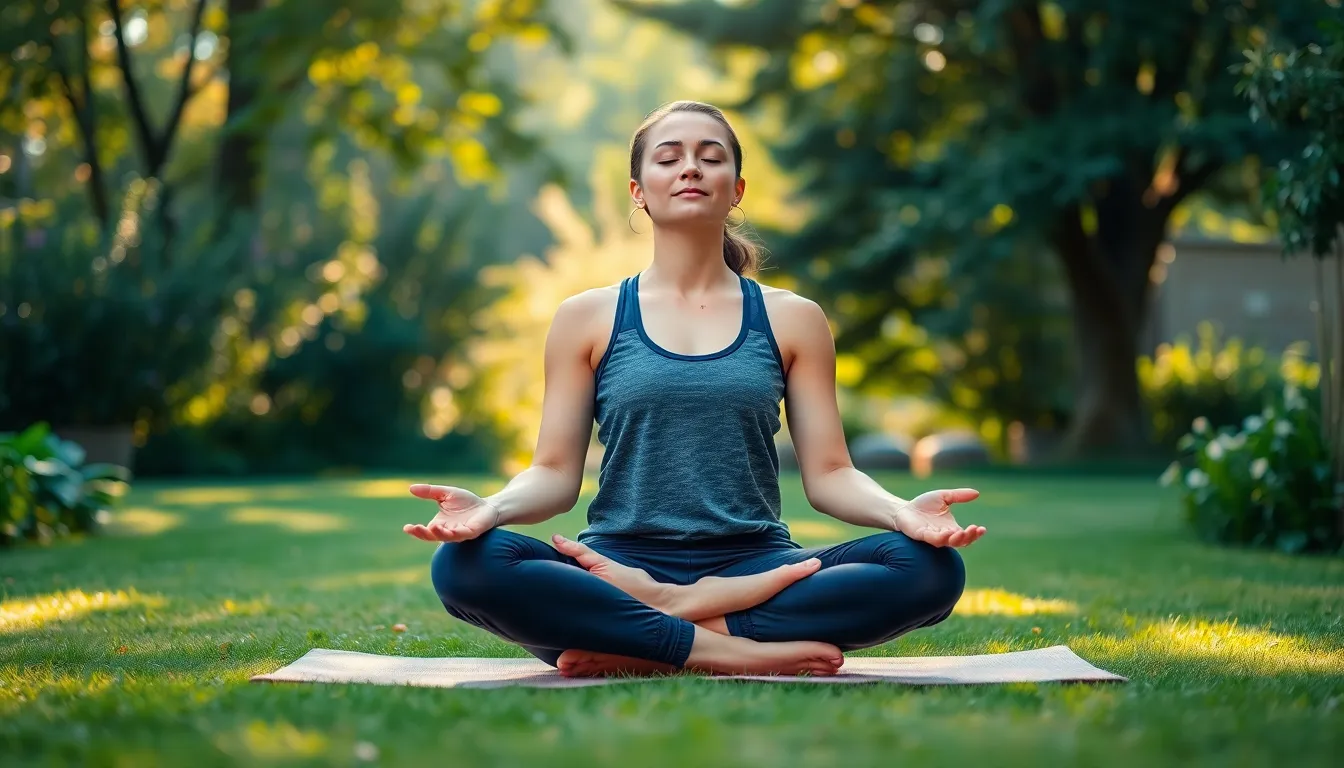Table of Contents
ToggleIn a world buzzing with chaos and endless to-do lists, finding inner peace might feel like searching for a needle in a haystack. Enter chakra meditation, the ancient practice that promises to align your energy centers and bring harmony back into your life. Imagine your chakras as a team of superheroes, each with a unique power ready to help you tackle stress, anxiety, and that pesky feeling of being overwhelmed.
What Is Chakras Meditation?
Chakras meditation centers around the concept of energy centers in the body. Each chakra corresponds to different physical, emotional, and spiritual aspects of a person’s well-being. Practitioners engage in this meditation to balance these energy centers, promoting overall health.
Individuals typically focus on seven main chakras, each with its own unique function. The root chakra, located at the base of the spine, connects to feelings of safety and grounding. The sacral chakra, situated in the lower abdomen, relates to creativity and pleasure. The solar plexus chakra, found in the upper abdomen, influences personal power and confidence.
Another important chakra is the heart chakra, which resides in the center of the chest and oversees love and compassion. The throat chakra enables communication and self-expression. The third eye chakra, located between the eyebrows, supports intuition and insight. Finally, the crown chakra, positioned at the top of the head, connects individuals to higher consciousness.
Meditation techniques usually involve visualization and breathwork. Practitioners often visualize each chakra as a colored light or spinning wheel. Focusing on each energy center can help release blockages and restore balance. This practice effectively reduces stress, anxiety, and feelings of being overwhelmed.
Many styles of meditation enhance the chakras experience. Guided meditations, chanting, and sound healing often accompany these practices. Engaging with these methods can deepen one’s understanding of their mind-body connection. Regular practice encourages individuals to tap into their inner strength, promoting a more harmonious lifestyle.
Benefits of Chakras Meditation

Chakras meditation offers various advantages that contribute to overall well-being. Practitioners can experience improvements across physical, mental, and spiritual domains.
Physical Benefits
Reduced tension and enhanced relaxation represent key physical benefits of chakra meditation. This practice encourages better circulation, which often supports overall physical health. Improved posture frequently occurs as individuals become more aware of their body alignment during meditation. Increased energy levels result from balanced chakras, allowing individuals to feel more invigorated throughout the day. Enhanced immune function is another benefit, stemming from reduced stress and improved emotional states.
Mental Benefits
Enhanced focus and clarity characterize the mental advantages of chakra meditation. Practitioners report reduced anxiety levels, leading to a calmer, more centered mindset. Improved emotional regulation helps individuals manage stress effectively. Many experience heightened creativity, as open chakras stimulate new ideas and perspectives. Sharper intuition often develops through regular practice, allowing individuals to make more informed decisions.
Spiritual Benefits
Deeper self-awareness and connection to one’s higher self exemplify the spiritual benefits of chakra meditation. Increased feelings of inner peace frequently emerge as practitioners balance their energy centers. Many individuals find themselves developing a stronger sense of purpose, leading to more meaningful life choices. A greater connection to the universe can enhance spiritual growth, fostering an understanding of life’s interconnectedness. Lastly, enhanced empathy and compassion arise, allowing individuals to cultivate better relationships with others.
How to Practice Chakras Meditation
Practicing chakra meditation involves preparation and following specific steps to enhance the experience. This practice draws on the energy centers in the body for improved well-being.
Preparing for Meditation
Create a calming atmosphere. Find a quiet space with minimal distractions, such as soft lighting or soothing sounds. Sitting comfortably in a cross-legged position or on a chair keeps the spine aligned. Focus on breathing; take deep, slow breaths to center the mind. Use crystals or essential oils related to specific chakras for added energy. Choose a comfortable length of time for meditation, typically ranging from 10 to 30 minutes, depending on personal preference.
Step-by-Step Guide
Start by closing the eyes softly and bringing attention to the breath. Inhale deeply through the nose, then exhale slowly through the mouth. Visualize the root chakra, located at the base of the spine, and imagine a vibrant red light glowing. Move up to the sacral chakra, visualizing an orange light, followed by the solar plexus chakra with yellow. Continue this pattern, visualizing green for the heart, blue for the throat, indigo for the third eye, and violet for the crown chakra. Maintain focus on each color for several breaths, allowing energy to flow freely. Conclude the session by taking a few deep breaths and gently reopening the eyes, feeling the body’s renewed energy and balance.
Common Challenges in Chakras Meditation
Chakra meditation presents some common challenges that practitioners face. Understanding these challenges can enhance the meditation experience.
Identifying Blockages
Identifying blockages in chakras can prove difficult for many. Each chakra represents specific emotions and physical aspects; therefore, people often overlook associated issues. Practitioners may feel uncertainty about sensing energy imbalances within themselves. Additionally, subtle feelings may not always manifest in noticeable ways. Techniques like mindfulness help individuals tune into their bodies and emotions, providing clarity on where blockages exist. Regular practice fosters greater awareness, enabling individuals to recognize patterns in their energy flow. Journaling thoughts and feelings during meditation aids in pinpointing areas needing attention, contributing to deeper self-awareness.
Maintaining Focus
Maintaining focus during chakra meditation often challenges practitioners. Distractions can arise from both internal and external sources, making it hard to stay centered. Wandering thoughts and external noises may lead to frustration. Establishing a comfortable and quiet environment significantly enhances focus. Practitioners can also utilize breathwork to ground themselves, returning attention to the present moment. Setting a specific intention before starting meditation creates a mental anchor, guiding thoughts back. Incorporating shorter sessions at first helps build concentration skills, eventually leading to deeper, prolonged meditative states.
Chakra meditation offers a powerful pathway to achieving balance and harmony in today’s hectic world. By focusing on the energy centers within the body, individuals can unlock a myriad of benefits that enhance their physical, mental, and spiritual well-being. This practice not only fosters relaxation and reduces stress but also promotes clarity and deeper self-awareness.
As practitioners explore various techniques like visualization and breathwork, they can cultivate a stronger connection to their inner selves and the world around them. Embracing chakra meditation can lead to a more fulfilling life, enriched with purpose and meaningful connections. By integrating this practice into daily routines, individuals can embark on a transformative journey toward holistic health and inner peace.







